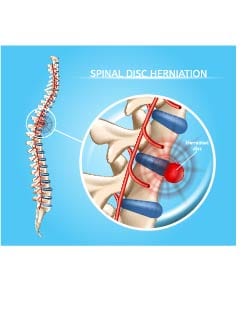
Low back pain is a common problem, affecting more than 80% of the population at some point in their life. There are many structures in the spine that can cause pain, including the spinal disks, the facet joints, and the ligaments that stabilize the spine. Low back pain is usually caused by injury or degeneration of one or another of these structures.
The spinal disks are oval in structure, resembling a jelly doughnut, with a strong fibrous ring called the annulus, surrounding a more gelatinous core, called the nucleus. Sometimes because of overuse or trauma, the annulus of the disk can tear, allowing the gel of the nucleus to squirt out of the gap and leak around the nearby nerves and cause an inflammatory response, which leads to localized back pain and referred pain down or along the leg. The nerve can become quite inflamed and swollen in a small space, compounding the problem. This can be quite debilitating and a suffering patient will often seek relief from surgery if this pattern persists for very long.
Surgery for pain involving a disk herniation is expensive and carries risks of infection, nerve injury and paralysis, and costs billions of dollars annually in the United States. Recovery from typical disk surgeries often takes months to over a year for simpler surgeries and may leave the patent with debilitating pain for many years if there are complications or if the surgery is extensive and includes the fusion of the spinal disks which locks the bones together using screws, rods, and plates.
A person suffering from a disk herniation will often wonder if there are proven alternatives to disk surgery. Thankfully, the answer is a resounding “yes”. Many therapies including Physical Therapy, Chiropractic and yoga have proven to be helpful for disk pain and nerve pain from disk herniation. A minimally invasive injection technique called an Epidural Steroid Injection into the areas where the disk is pressing on the nerve can be very helpful to reduce the disk inflammation and swelling that occurs. This can help to allow the patient to be more functional while the natural process of healing occurs, and will often reduce the urgency caused by the severe pain while promoting healing of the swollen nerve.
Research over the last 10 years has proven that there is now great promise to eliminate surgery for many of these disk tears. Injections of growth factors including Platelet-Rich Plasma (PRP) and Stem Cells from the patient’s own blood and Bone Marrow can stimulate repair of the torn disk annulus. This is done using precise X-Ray guidance in the office of a skilled Regenerative Medicine Specialist in a procedure that takes less than 2 hours and which has minimal pain and far less risk and cost than surgery. Disk herniations have been shown to shrink, disk tears will usually repair, and the nerve compression usually resolves. Other ligaments and joints in the region that might contribute to the overall pain pattern can easily be treated at the same time.
With a combination of advanced Regenerative Medicine treatments using the patient’s own platelets, stem cells and growth factors, and a well-designed Physical Therapy program, most spine pain from disk herniation and the associated nerve pain can be reduced or resolved without surgery.



